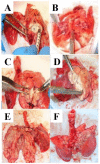13[C]-urea breath test as a novel point-of-care biomarker for tuberculosis treatment and diagnosis
- PMID: 20805989
- PMCID: PMC2929202
- DOI: 10.1371/journal.pone.0012451
13[C]-urea breath test as a novel point-of-care biomarker for tuberculosis treatment and diagnosis
Abstract
Background: Pathogen-specific metabolic pathways may be detected by breath tests based on introduction of stable isotopically-labeled substrates and detection of labeled products in exhaled breath using portable infrared spectrometers.
Methodology/principal findings: We tested whether mycobacterial urease activity could be utilized in such a breath test format as the basis of a novel biomarker and diagnostic for pulmonary TB. Sensitized New-Zealand White Rabbits underwent bronchoscopic infection with either Mycobacterium bovis or Mycobacterium tuberculosis. Rabbits were treated with 25 mg/kg of isoniazid (INH) approximately 2 months after infection when significant cavitary lung pathology was present. [(13)C] urea was instilled directly into the lungs of intubated rabbits at selected time points, exhaled air samples analyzed, and the kinetics of delta(13)CO(2) formation were determined. Samples obtained prior to inoculation served as control samples for background (13)CO(2) conversion in the rabbit model. (13)CO(2), from metabolic conversion of [(13)C]-urea by mycobacterial urease activity, was readily detectable in the exhaled breath of infected rabbits within 15 minutes of administration. Analyses showed a rapid increase in the rate of (13)CO(2) formation both early in disease and prior to treatment with INH. Following INH treatment, all evaluable rabbits showed a decrease in the rate of (13)CO(2) formation.
Conclusions/significance: Urea breath testing may provide a useful diagnostic and biomarker assay for tuberculosis and for treatment response. Future work will test specificity for M. tuberculosis using lung-targeted dry powder inhalation formulations, combined with co-administering oral urease inhibitors together with a saturating oral dose of unlabeled urea, which would prevent the delta(13)CO(2) signal from urease-positive gastrointestinal organisms.
Conflict of interest statement
Figures





References
-
- Andries K, Verhasselt P, Guillemont J, Göhlmann HW, Neefs JM, et al. A diarylquinoline drug active on the ATP synthase of Mycobacterium tuberculosis. Science. 2005;14:223–227. - PubMed
-
- Stover CK, Warrener P, VanDevanter DR, Sherman DR, Arain TM, et al. A small-molecule nitroimidazopyran drug candidate for the treatment of tuberculosis. Nature. 2000;405:962–966. - PubMed
-
- Perrin FM, Lipman MC, McHugh TD, Gillespie SH. Biomarkers of treatment response in clinical trials of novel antituberculosis agents. Lancet Infect Dis. 2007;7:481–490. - PubMed
-
- Wallis RS, Doherty TM, Onyebujoh P, Vahedi M, Laang, et al. Biomarkers for tuberculosis disease activity, cure, and relapse. Lancet Infect Dis. 2009;9:162–172. - PubMed
Publication types
MeSH terms
Substances
Grants and funding
LinkOut - more resources
Full Text Sources
Other Literature Sources
Medical

